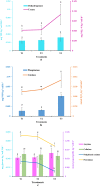Enzymatic defense of Cyperus brevifolius in hydrocarbons stress environment and changes in soil properties
- PMID: 33436992
- PMCID: PMC7804112
- DOI: 10.1038/s41598-020-80854-5
Enzymatic defense of Cyperus brevifolius in hydrocarbons stress environment and changes in soil properties
Abstract
Hydrocarbons or crude oil contamination of soil is still a burning problem around the globe. The herbs competent that are to survive in hydrocarbons contaminated habitats have some adaptive advantages to cope up with the adverse situations prevailing in that environment. In the present study, the adaptive response of Cyperus brevifolius in the heavily polluted soil with crude oil has been investigated in terms of survivability, changes in productivity, antioxidants, phytochemicals and functional group pro files of the plant species. Besides, changes in enzymes, beneficial bacterial population and physico-chemical conditions of contaminated soil were also studied during 60 days of experimental trials. The results showed significant enhancement in activities of soil dehydrogenase, urease, alkaline phosphatase, catalase, and amylase whereas reduction in cellulase, polyphenol oxidase and peroxidase activities. There was a significant increase in nitrogen fixing, phosphate and potassium solubilizing bacterial population, improvement in physico-chemical conditions and a decrease in total oil and grease (TOG) levels. Besides there was significant variations in the productivity parameters and antioxidant profiles of Cyperus brevifolius in hydrocarbons stress condition suggesting enzymatic defense of the herb. The fourier-transform infrared (FT-IR) analysis indicated uptake and metabolism of some hydrocarbon components by the experimental plant from the hydrocarbons polluted soil.
Conflict of interest statement
The authors declare no competing interests.
Figures


Similar articles
-
Understanding biochemical defense and phytoremediation potential of Leucas aspera in crude oil polluted soil.Environ Sci Pollut Res Int. 2022 Aug;29(38):57579-57590. doi: 10.1007/s11356-022-19922-4. Epub 2022 Mar 30. Environ Sci Pollut Res Int. 2022. PMID: 35355178
-
Effects on anatomy of some abundantly growing herbs in the effluents contaminated soil of oil refinery.Environ Sci Pollut Res Int. 2021 Mar;28(9):11549-11557. doi: 10.1007/s11356-020-11407-6. Epub 2020 Oct 30. Environ Sci Pollut Res Int. 2021. PMID: 33128153
-
Field note: phytoremediation of petroleum sludge contaminated field using sedge species, Cyperus rotundus (Linn.) and Cyperus brevifolius (Rottb.) Hassk.Int J Phytoremediation. 2013;15(9):877-88. doi: 10.1080/15226514.2012.760520. Int J Phytoremediation. 2013. PMID: 23819282
-
Effect of crude oil contamination on the chlorophyll content and morpho-anatomy of Cyperus brevifolius (Rottb.) Hassk.Environ Sci Pollut Res Int. 2014 Nov;21(21):12530-8. doi: 10.1007/s11356-014-3195-y. Epub 2014 Jun 20. Environ Sci Pollut Res Int. 2014. PMID: 24946711
-
Phytosociology and antioxidant profile study for selecting potent herbs for phytoremediation of crude oil-contaminated soils.Environ Monit Assess. 2020 Nov 18;192(12):766. doi: 10.1007/s10661-020-08721-4. Environ Monit Assess. 2020. PMID: 33210208
Cited by
-
Reduction of hydrocarbon pollutants by hyacinth plants ( Eichhornia crassipes).F1000Res. 2023 Sep 12;12:728. doi: 10.12688/f1000research.131846.2. eCollection 2023. F1000Res. 2023. PMID: 39132581 Free PMC article.
-
Nanosilicon: An approach for abiotic stress mitigation and sustainable agriculture.Front Plant Sci. 2022 Dec 23;13:1025974. doi: 10.3389/fpls.2022.1025974. eCollection 2022. Front Plant Sci. 2022. PMID: 36618645 Free PMC article. Review.
-
Rapid Detection of Total Petroleum Hydrocarbons in Soil Using Advanced Fluorescence Imaging Techniques.ACS Omega. 2024 Jun 27;9(27):29350-29359. doi: 10.1021/acsomega.4c01298. eCollection 2024 Jul 9. ACS Omega. 2024. PMID: 39005835 Free PMC article.
-
Microbiological Study in Petrol-Spiked Soil.Molecules. 2021 May 1;26(9):2664. doi: 10.3390/molecules26092664. Molecules. 2021. PMID: 34062889 Free PMC article.
References
-
- Devatha CP, Vishnu Vishal A, Purna Chandra Rao J. Investigation of physical and chemical characteristics on soil due to crude oil contamination and its remediation. Appl. Water Sci. 2019;9(4):1–10. doi: 10.1007/s13201-019-0970-4. - DOI
-
- Chaudhary DK, Kim J. New insights into bioremediation stratecgies for oil-contaminated soil in cold environments. Int. Biodeterior. Biodegrad. 2019;142:58–72. doi: 10.1016/j.ibiod.2019.05.001. - DOI
-
- Aisien FA, Aisien ET, Oboh IO. Phytoremediation of petroleum-polluted soils. Phytoremediation. 2015;1:243–252. doi: 10.1007/978-3-319-10395-2_16. - DOI
-
- Basumatary B, Bordoloi S, Sarma HP. Crude oil-contaminated soil phytoremediation by using cyperus brevifolius (Rottb.) Hassk. Water Air Soil Pollut. 2012;223(6):3373–3383. doi: 10.1007/s11270-012-1116-6. - DOI
LinkOut - more resources
Full Text Sources
Other Literature Sources

